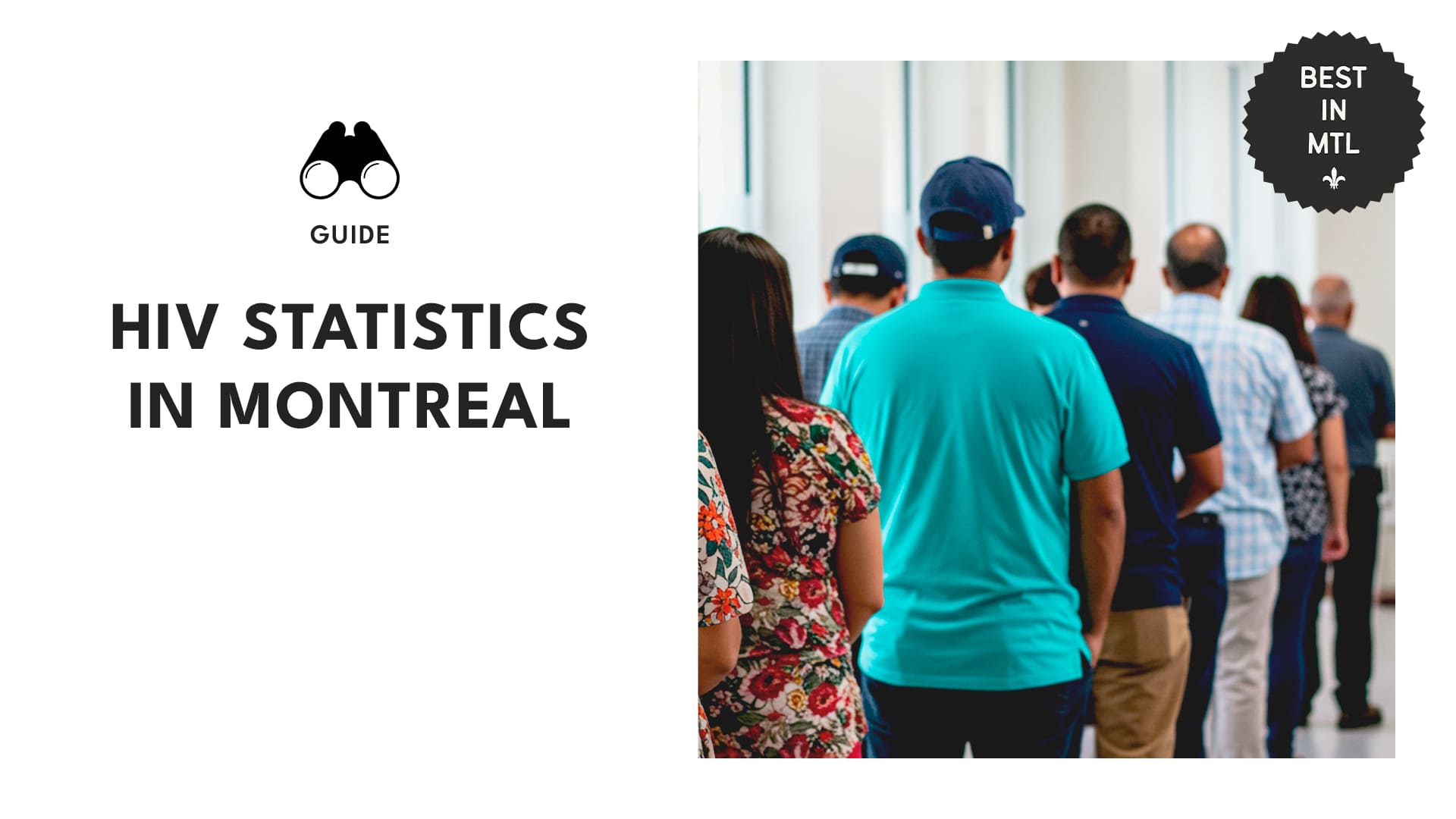The latest HIV statistics in Montreal: Trends, challenges, and interventions
Key Insights
| As per the CBC, Canada experienced a 25% increase in new HIV cases in 2022, while Montreal saw a 120% rise in cases from 2010 to 2022, marking the largest increase in decades. Men aged 30 to 39 accounted for 74% of new HIV diagnoses in Montreal, according to Global News. In addition, immigrants from Africa and the Caribbean made up 51% of new cases in 2022. According to the National Library of Medicine, 32% of HIV-negative men who have sex with men (MSM) report low or no HIV prevention method use. A study reveals that Montreal has the strongest testing rates (74.9%) compared to Vancouver and Toronto. However, it also has the lower PrEP use (9.6%) compared to the two other cities. |
HIV cases in Montreal are on the rise, and it’s sparking growing concern among health experts.
According to a CBC report, the significant 120% rise in HIV diagnoses in Montreal in 2022 marks the largest increase in the past decades. This highlights a big jump in cases, from 141 in 2010 to 310 in 2022.
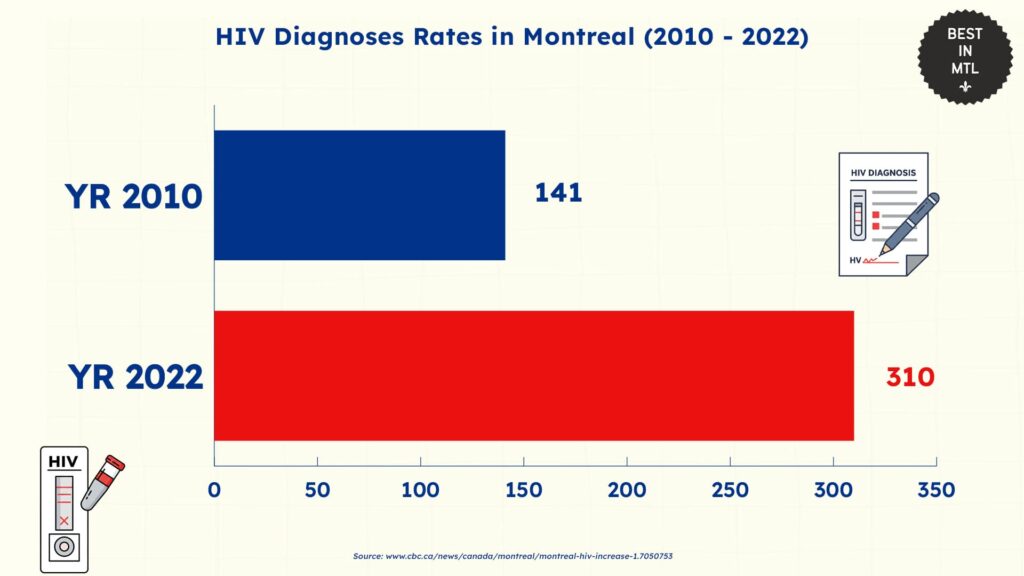
This isn’t happening in Montreal alone. The entire Canada also saw a 25% rise in new HIV cases in the same year, reaching 1,833 diagnoses, as per the experts in Montreal Public Health.
While the increase is alarming, experts attribute it partially due to expanded testing efforts. This may have uncovered cases that would have otherwise gone undiagnosed,
According to a report by The Gazette, a key factor in this rise is the disproportionate impact on two specific groups: men who have sex with men and newcomers from HIV-endemic regions, particularly in Africa and the Caribbean.
Cases among the latter group saw a dramatic increase, rising from 32 in 2021 to 158 in 2022. With concerning rates of HIV cases, there is a clear, ongoing need for targeted prevention efforts.
Prevalence of HIV in Montreal Compared to Other Regions
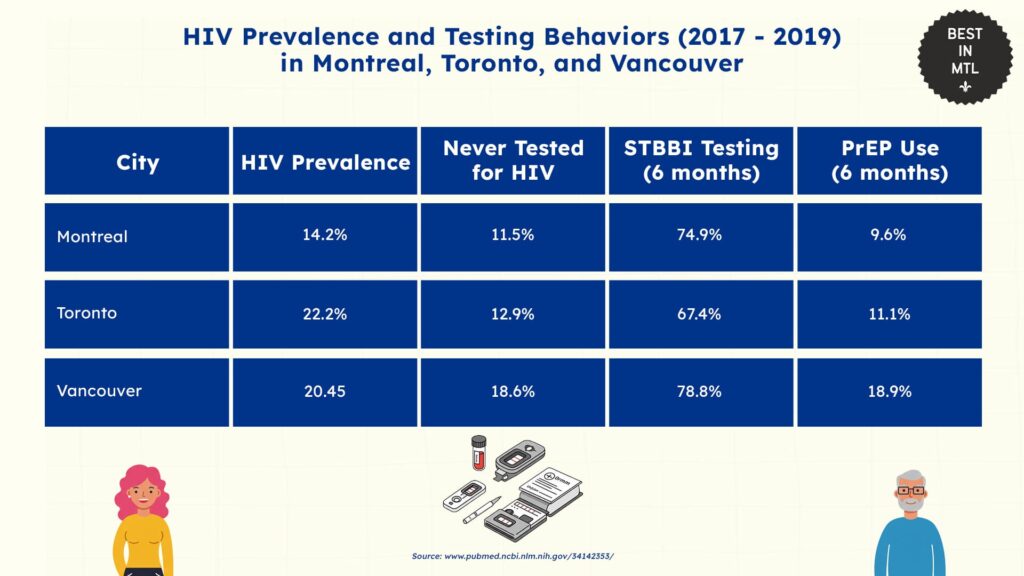
The HIV epidemic in Canada saw a sharp resurgence in 2022, with a 24.9% increase in reported cases nationwide, according to the Canadian Foundation for AIDS Research.
According to a CTV News report, Quebec slightly exceeded the national average HIV rate, reporting 4.9 cases per 100,000 inhabitants compared to Canada’s 4.7.
A 2021 study published in the National Library of Medicine provides insights into HIV and sexually transmitted and blood-borne infection (STBBI) prevalence among gay, bisexual, and other men who have sex with men in Montreal, Toronto, and Vancouver.
The study found that between 2017 and 2019, Montreal had a lower HIV prevalence of 14.2%. In comparison, Toronto had a rate of 22.2% and Vancouver had a rate of 20.4%.
Despite its lower HIV prevalence, Montreal had a relatively high rate of STBBI testing, with 74.9% of participants having testing in the past six months.
This closely follows Vancouver’s 78.8% and Toronto’s 67.4%.
However, Montreal had the lowest reported use of pre-exposure prophylaxis (PrEP) at 9.6%, which is slightly lower than Toronto (11.1%) and Vancouver (18.9%).
This suggests that while testing rates are strong in Montreal, there may be a gap in the adoption of preventive measures like PrE.
Another key finding in the study was that Montreal had the lowest proportion of HIV-negative or unknown-status participants who’ve never been tested for HIV at 11.5%
For reference, Toronto’s proportion is at 12.9% and Vancouver’s is at 18.6%
Overall, the study highlights significant regional differences in HIV prevalence, testing, and prevention behaviors. While Montreal performs well in testing, the lower uptake of PrEP suggests a need for better access and education in preventive medication.
Demographics of HIV in Montreal
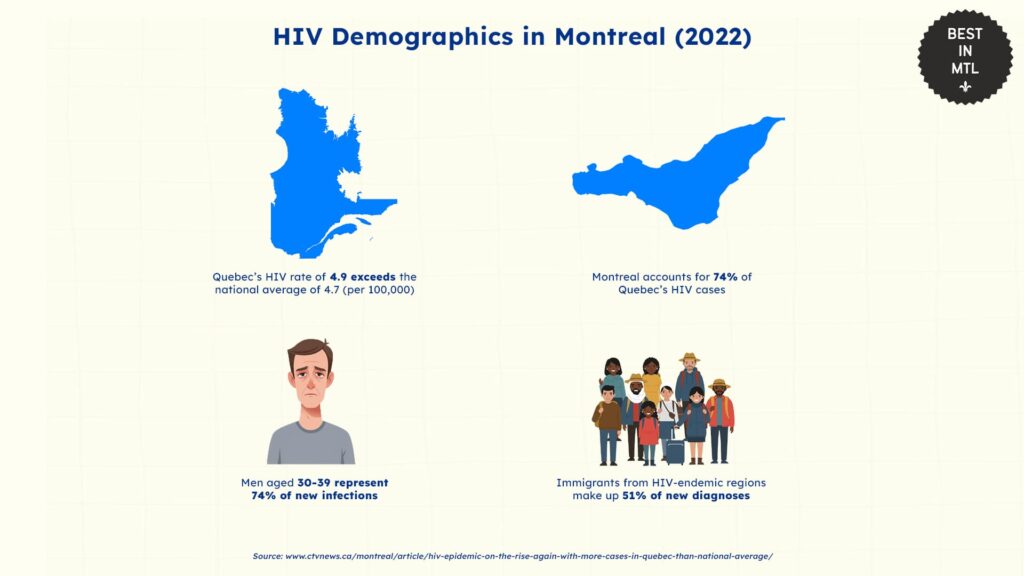
Montreal’s high concentration of cases suggests that the city remains a hotspot for transmissions. According to Global News, it makes up 74% of Quebec’s total in 2022, up from the usual 60%.
Age Group
Men aged 30 to 39 represented the group with the highest rates of new infections. Overall, they make up 74% of new diagnoses in Montreal.
Immigrants From HIV-Endemic Regions
Another key factor in the rising HIV numbers is the significant increase in cases among new immigrants. In particular, immigrants from Africa and the Caribbean accounted for 51% of new diagnoses in 2022, which recorded a 394% jump from 2021 to 2022.
Notably, 92% of those who tested positive in this group had arrived in Canada that same year.
High-Risk Populations in Montreal
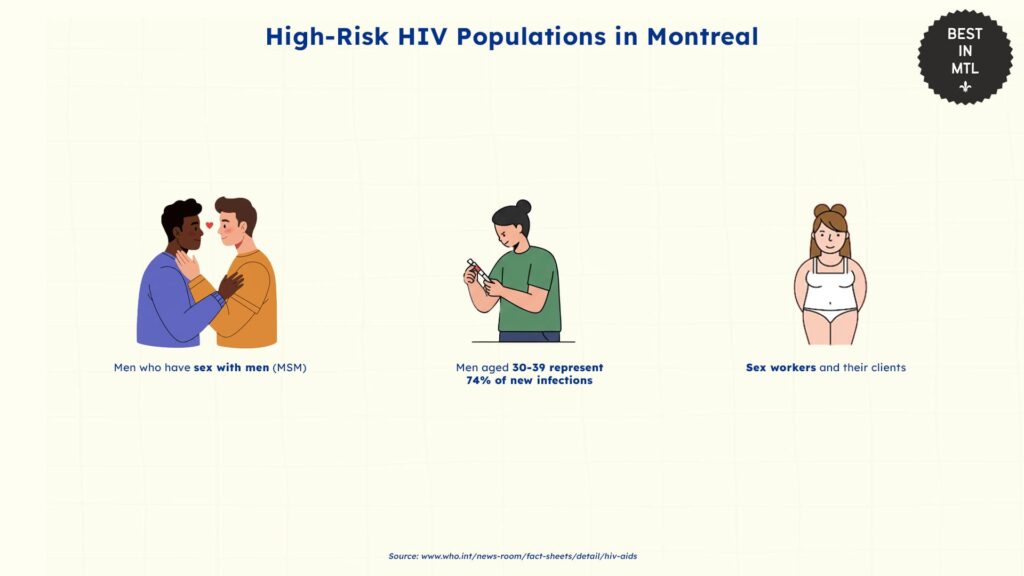
Certain Groups are at higher risk of contracting HIV due to behavioral, social, and structural factors. These include:
- Men who have sex with men (MSM): Representing a large proportion of new HIV cases in Montreal, MSM are at increased risk due to factors such as multiple partners and inconsistent condom use.
- People who inject drugs: WHO estimates that 1 in 10 new global HIV infections occur in this group.
- Sex workers and their clients: Increased exposure to multiple partners with inconsistent usage of sexual protection elevates transmission risks.
Transmission Modes and Risk Factors of HIV in Montreal
Similar to HIV prevalence anywhere in the world, transmission modes and risks are the same in Montreal. Generally, HIV is transmitted through the exchange of bodily fluids, including blood, semen, vaginal fluids, and breast milk.
Modes of HIV Transmission
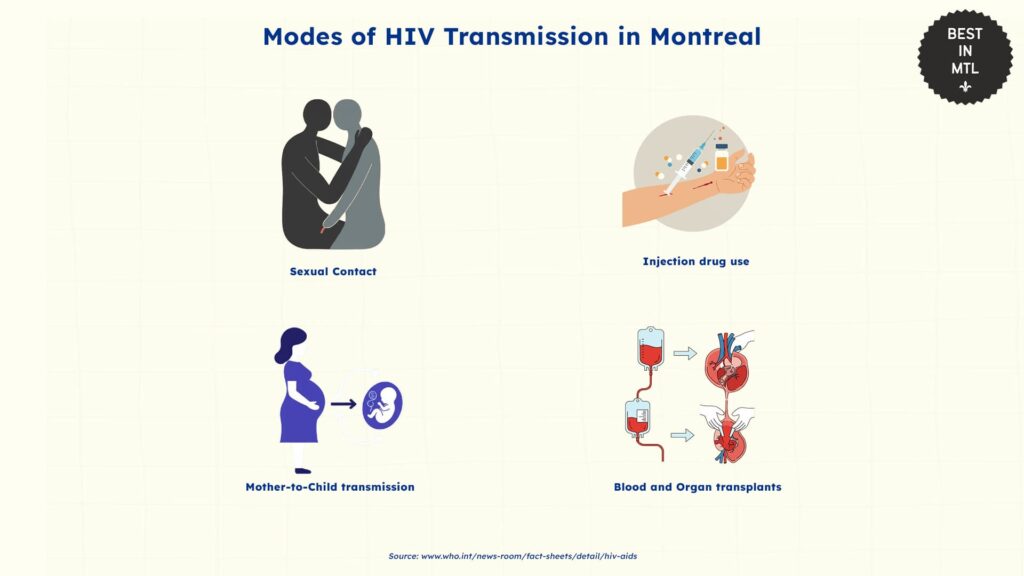
In Montreal, as in other regions around the world, the main transmission routes include:
- Sexual Contact: Unprotected sex anal or vaginal sex remains the leading cause of HIV transmission.
- Injection Drug Use: Sharing needles and syringes significantly increases transmission risks. The World Health Organization (WHO), highlights that 10% of new HIV infections worldwide occur among people who inject drugs.
- Mother-to-Child Transmission: HIV can be passed from mother to child during pregnancy, childbirth, or breastfeeding.
- Blood and Organ Transplants: Although rare, HIV transmission can still occur through unscreened blood transfusions or organ transplants.
Risk Factors Contributing to HIV Transmission
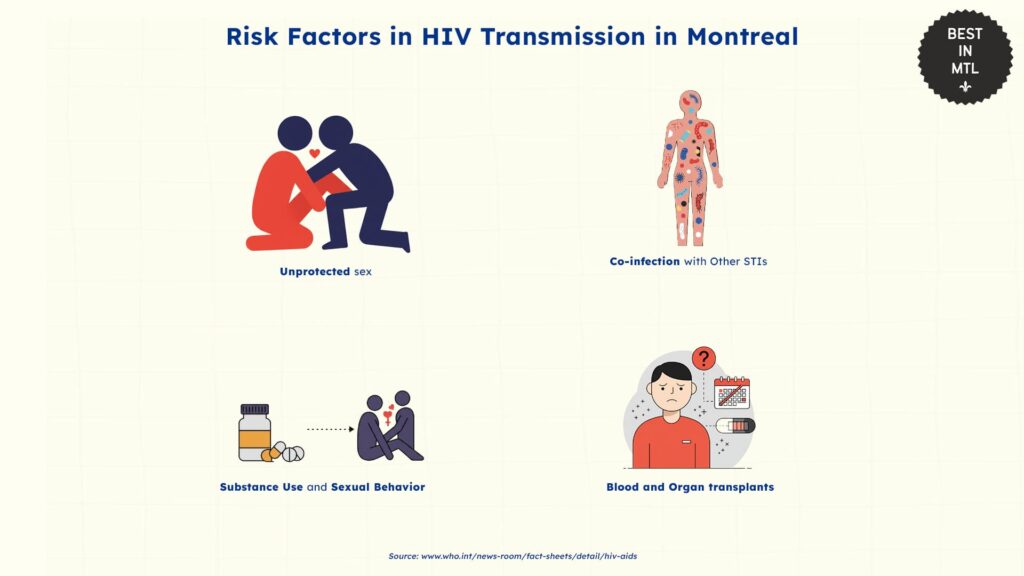
Several factors contribute to the spread of HIV in Montreal, including:
- Unprotected Sex: WHO states that over 75% of new HIV infections in adults occur through sexual transmission.
- Co-infection with Other STIs: Infections like syphilis (which has a 14% to 16% prevalence across Canadian cities as per a National Library of Medicine study) increase susceptibility by causing open pores and inflammation.
- Substance Use and Sexual Behavior: Alcohol and drug use impair judgment, leading to risky sexual behaviors.
- Lack of Regular Testing: Regular testing is necessary to diagnose HIV immediately and address the issue, especially for those who are unaware of their status.
Rate of Usage of HIV Prevention Strategies in Montreal
HIV prevention strategies among gay, bisexual, and other men who have sex with men (GBM) in Montreal have changed ever since PrEP was introduced in 2013.
However, a 2021 study published by the National Library of Medicine shows that PrEP uptake remains low. Data shows that only 7% of HIV-negative or status-unknown GMB use biomedical prevention methods, including PrEP.
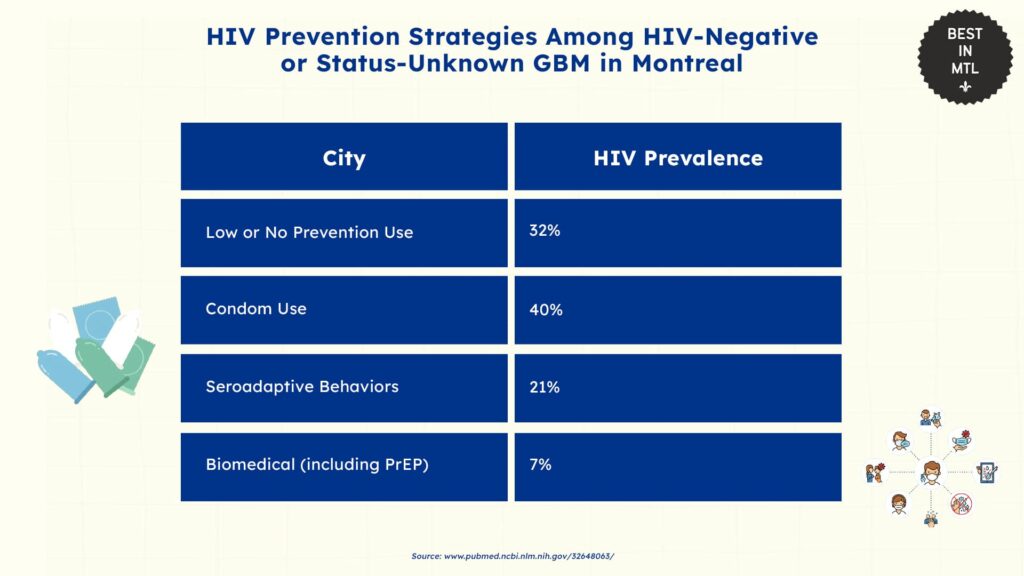
As per the study, among HIV-negative or unknown-status GBM, prevention strategies vary significantly. Approximately 40% of individuals rely on condom use, while 21% engage in seroadaptive behaviors (e.g. strategic positioning to reduce HIV Risk.
Notably, 32% reported low or no use of prevention methods, suggesting gaps in awareness, accessibility, or willingness to engage in available HIV prevention strategies.
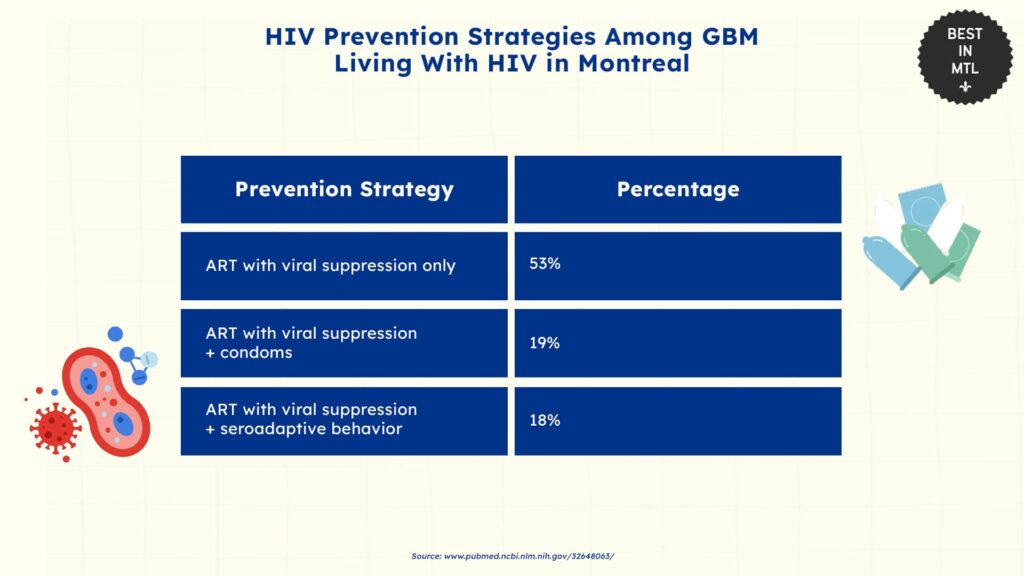
For GBM living with HIV, antiretroviral treatment (ART) with viral suppression also aids in HIV prevention.
More than half of GMB living with HIV (53%) rely solely on ART to maintain an undetectable viral load. Meanwhile, 19% combine ART with condom use, and another 18% incorporate seroadaptive behaviors alongside ART.
These patterns suggest that while treatment-as-prevention (TasP) is widely accepted, some individuals still choose to incorporate additional risk-reduction measures.
References
- CBC. Montreal saw a 120% increase in HIV diagnoses last year (2023). https://www.cbc.ca/news/canada/montreal/montreal-hiv-increase-1.7050753
- CTV News. HIV epidemic on the rise again, with more cases in Quebec than national average (2024). https://www.ctvnews.ca/montreal/article/hiv-epidemic-on-the-rise-again-with-more-cases-in-quebec-than-national-average/
- Global News. HIV diagnoses hit 10-year high in Montreal, cases more than double between 2021-22 (2023). https://globalnews.ca/news/10156520/hiv-diagnoses-montreal-2022/
- Government of Canada. HIV in Canada: 2022 surveillance highlights (2022). https://www.canada.ca/en/public-health/services/publications/diseases-conditions/hiv-2021-surveillance-highlights.html
- Government of Canada. HIV in Canada: 2021 surveillance highlights (2021). https://www.canada.ca/en/public-health/services/publications/diseases-conditions/hiv-2021-surveillance-highlights.html
- McGill. Expert: HIV epidemic on the rise, with more cases in Quebec than national average (2024). https://www.mcgill.ca/newsroom/channels/news/expert-hiv-epidemic-rise-more-cases-quebec-national-average-356224
- National Library of Medicine. Prevalence of HIV and sexually transmitted and blood-borne infections, and related preventive and risk behaviours, among gay, bisexual and other men who have sex with men in Montreal, Toronto and Vancouver: results from the Engage Study (2021). https://pubmed.ncbi.nlm.nih.gov/34142353/
- National Library of Medicine. Combination HIV Prevention Strategies Among Montreal Gay, Bisexual, and Other Men Who Have Sex with Men in the PrEP Era: A Latent Class Analysis (2021). https://pubmed.ncbi.nlm.nih.gov/32648063/
- The Gazette. Why HIV cases — and syphilis — have risen sharply in Montreal (2024). https://www.montrealgazette.com/news/article130294.html
- World Health Organization. HIV and AIDS (2024). https://www.who.int/news-room/fact-sheets/detail/hiv-aids







